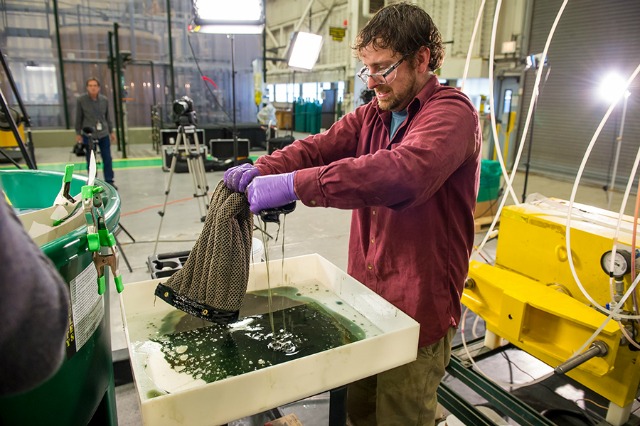Video: This Incredible, Hyper-Absorbent Sponge Could Transform Oil Spill Cleanup
By Stephen Gossett in News on Mar 9, 2017 5:14PM

Argonne postdoctoral researcher Ed Barry wrings out a sheet of Oleo Sponge. Photo: Mark Lopez/Courtesy of Argonne National Laboratory
While their colleagues continue to wrestle with how best to approach the zombie apocalypse, researchers at Argonne National Laboratory have developed what looks like a breakthrough in sadly all-too-real catastrophe management: a hyper-absorbent, reusable sponge the soaks up the hard-to-recover oil and petroleum that floats below the surface in oil spills.
The foam device, which is dubbed the Oleo Sponge causes no environmental damage; and—like the sponge itself—the oil that it soaks up from the water can be reused. The foam has gobbled up 90 times its weight in oil during research tests.
“The Oleo Sponge offers a set of possibilities that, as far as we know, are unprecedented,” said co-inventor Seth Darling, a scientist with Argonne’s Center for Nanoscale Materials and a fellow of the University of Chicago’s Institute for Molecular Engineering, in a release.
Here's how it works: scientists combine a polyurethane foam, common to a variety of household products, including sofa cushions, with a special "primer" that applies a previously developed technique called sequential infiltration synthesis. The "glue" of the latter and the absorption of the former soaks up oil from the water so quickly and so thoroughly that, in the video demonstration below, you half expect Billy Mays from OxiClean to jump out and give you the hard sell.
"The material is extremely sturdy. We’ve run dozens to hundreds of tests, wringing it out each time, and we have yet to see it break down at all,” Darling said.
Researchers are now actively pursuing commercialization and manufacturing options for Oleo, a business development executive with Argonne’s Technology Development and Commercialization division said.
Try as some might, you can't keep good science down.